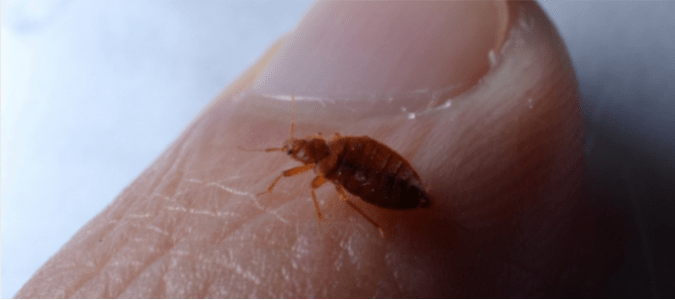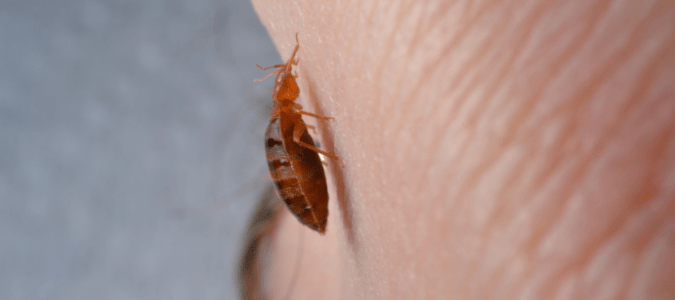
Anyone who has dealt with a bed bug infestation has probably wondered how to get rid of bed bugs permanently. Considered by many in the pest control industry as among the most difficult problems to resolve, bed bugs can live for several months without eating, and are capable of laying up to 5 eggs each day, and over 500 over a lifetime. Able to survive in temperatures ranging from almost freezing to 122 degrees Farenheit, bed bugs are extremely resilient. To make matters worse, newly-hatched bed bugs are so tiny that they can squeeze in between the stitches of a mattress. These are just a few reasons why homeowners often skip DIY treatments and enlist the help of a professional, who is equipped with the products, techniques and experience needed to resolve an infestation both quickly and effectively.
If you believe you may have a bed bug problem, you should know that it’s far easier to prevent bed bugs from infesting your home than to get rid of them once they’ve settled in. In many cases, homeowners assume they have eliminated all of these creatures from their property, only to be mistaken. Just when your life is getting back to normal, bed bugs can emerge from their hiding spots under the cover of darkness and feed on us in the middle of the night, thereby getting enough nutrients to reproduce and prolong your infestation.
To minimize the chances that you might bring bed bugs home, it’s always a good idea to take precautionary measures and understand where bed bugs come from. Vacations, for example, are supposed to be relaxing and fun, but many travelers find that the aftermath is quite the opposite if they find themselves covered in bites and wondering how to get rid of these unwanted hitchhikers.
To avoid bed bugs when you’re traveling, take these precautions:
- Check reviews to make sure your hotel has a good reputation and pay particular attention to any references to pest control and cleanliness.
- Keep your luggage off the floor whenever possible by using a luggage rack and keeping your suitcases zipped shut when not in use.
- Protect clothing inside sealed plastic bags.
- Since bed bugs can infest drawers, as well as other furniture items, it’s best either to keep your things in your suitcase or hang them on hangers in the closet.
- Bring a flashlight with you or use the one on your phone to do a brief inspection before settling into your room. Pull back the pillowcases on the hotel pillows and look for small, dark brown or rust-colored spots that might indicate the presence of bed bugs.
- Similarly, pull back the sheets and inspect the mattress for dark-brown or rust-colored spots, or anything suspicious along the seams. Bed bugs often hide along mattress seams, tucked in the fold of the piping that runs along the edge. If these bugs are present, you might spot black or rust-colored spots, shed skins or actual bed bug bodies, whether dead or alive.
Also when traveling, remember that bed bugs don’t only stick to beds, or even just hotel rooms. Travelers have encountered bed bugs even on buses and trains, which means you should inspect your seat and surroundings for signs of bed bugs before you set down your clothes, get comfortable on a hotel couch or use ground transportation.
When you return home from a trip, protect yourself and your home by washing all your clothing from the trip in hot water and then drying it on a high-heat setting, if possible. It’s also a good idea to be cautious about purchasing secondhand clothing, bedding, furniture or other items, whether from individuals or from a store. If you do purchase used items, be sure to inspect them very carefully before bringing them into your home. If possible, wash the items in hot water and dry on high heat before putting items away.
If you do have bed bugs and choose a do-it-yourself approach to getting rid of them, there are several things to keep in mind. First, while washing your bedding and drying it on high heat can kill off many live bugs and their eggs, you’ll also have to get rid of the bugs in all stages of their life cycle, including their eggs, that may still be present on your mattress as well as in crevices in your bed frame, between the bed and the wall, between floorboards and in other areas. A thorough vacuuming can help eliminate bed bugs, but it won’t be very effective in getting rid of their eggs. In households with children and pets, it’s usually a better idea to hire a pest control specialist to treat bed bugs rather than trying to deal with the problem on your own.
Bed bugs can make anyone’s skin crawl. If you have multiple bed bugs in a room, you likely have an infestation. However, if you have only found one or two bed bugs, it can be difficult to determine the severity of your situation.

Common Question: “I Found One Bed Bug—Does This Mean There Are More?”
Finding even a single bed bug can strike fear into your heart, as bed bug infestations can be devastating to a household. These pests are extremely difficult to eliminate, especially if a multi-faceted approach isn’t used or the proper extermination steps aren’t followed. Worse still, the presence of these pests can exact a genuine emotional toll on everyone living in the house.
If you’ve found just one or two bed bugs and you aren’t sure whether you have a full-blown infestation on your hands, here’s what to do next.
First, let’s make sure what you’ve found actually is a bed bug. There are several different bugs that are commonly confused with these insects. When they haven’t fed recently, bed bugs are about the size and color of apple seeds, with flat, medium-brown, oval-shaped bodies that are about a quarter-inch across. These creatures live on animal blood, and their bodies swell and grow darker in color when they feed. Bed bugs often hide not only in beds themselves, but also in bed frames, behind wall hangings or wallpaper or even in crevices in dresser drawers or between wooden floorboards.
Cockroach nymphs are a common household pest that can be confused with bed bugs. Like bed bugs, these very young roaches are small, flat and brown, but their bodies are less oval-shaped and more elongated than bed bugs’ bodies. Bed bugs can crawl relatively quickly across floors and walls when they’re on the move, but cockroaches are likely to move even faster, darting for cover when disturbed. Bed bugs, on the other hand, typically remain unseen during daylight hours—so no quick movements are generally necessary. They usually come out only at night, under the cover of darkness, to feed on the blood of their sleeping prey. Cockroaches, on the other hand, typically do not bite and they don’t usually consume human blood.
Determining whether you have found a bed bug or tick can also be difficult for homeowners. Like bed bugs, ticks do bite humans and feed on human blood, but they are usually smaller than bed bugs and darker in color.
There are even other types of insects and other bugs that look like bed bugs. If you find something in your home that you think might be a bed bug, it’s a good idea to have a professional exterminator look at it to confirm what type of insect it is, whether there may be others around and, if so, how to eliminate them.
You can also determine if you have an infestation by looking for the following signs of bed bug activity:
- Small spots that are blackish, dark-brown or rust-colored, on the sheets, pillows or mattress—these could be blood spots or bed bug fecal matter stains
- Shed skins that have been discarded by molting bed bug nymphs
- An odd, musty odor emanating from where the bed bugs congregate
- Multiple itchy bites that may be arranged in lines on the body (some people refer to these bites as “breakfast, lunch and dinner,” since bed bugs will take a bite at one spot and feed for a few minutes, and then crawl to another spot to feed there for a few minutes)
If you’ve found even just one bed bug, or if you’ve found one or more of the other signs of bed bug activity listed above, and you feel pretty certain that you’re dealing with a bed bug infestation, it’s a good time to reach out to a pest control professional. It’s unlikely that you have just a single bed bug in your home; it’s far more likely that it’s a full-on infestation. If so, you’ll want to call in a professional exterminator who can recommend a plan so that you can take back your home from these pesky pests.

Are Bed Bugs Dangerous?
Since these insects actually bite people and feed on their blood, many homeowners worry about whether they have venom or pose any other health risks. Fortunately, bed bugs are not known carriers of diseases, and they don’t transmit illnesses to humans through their bite. This is one big difference between bed bug bites and mosquito bites.
That said, bed bugs are considered a public health concern by government agencies. Bed bug bites are notoriously itchy, and excessive scratching has been known to lead to secondary infections—even serious ones, such as staph and MRSA. Itchy bites can also have more minor adverse effects, such as poor or interrupted sleep due to scratching throughout the night. Bed bugs and their bites often have a negative psychological impact on people, causing anxiety and nervousness in people who just want these pests to be gone forever so they can feel safe in their homes again.
Not everyone reacts to bed bug bites in the same way, of course. Some people don’t find their bites to be itchy, and don’t feel nervous or anxious about the prospect of trying to get rid of a bed bug infestation. There’s a lot of peace of mind to be found in handing the problem over to a pest control specialist to tackle, rather than prolonging an infestation by trying to do it yourself.
ABC Can Bring You And Your Family Comfort
Bed bug infestations are exhausting, partially due to lack of sleep and also because of the emotional toll these pests can take on you. In addition, home remedies don’t work with a pest this resilient. Instead of spending considerable time and energy on such a difficult pest problem, contact ABC Home & Commercial Services. Our specialists will effectively target and eliminate these pests so you can feel comfortable again in your home.
